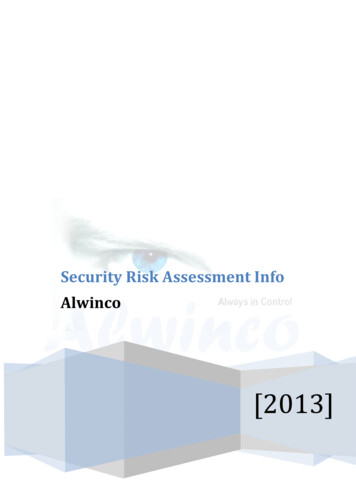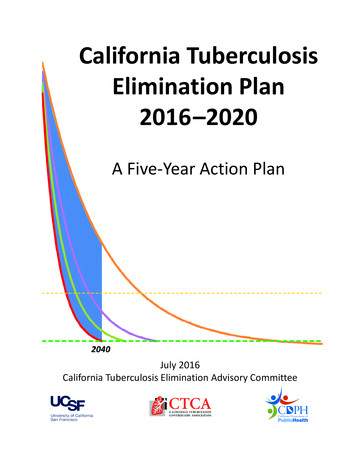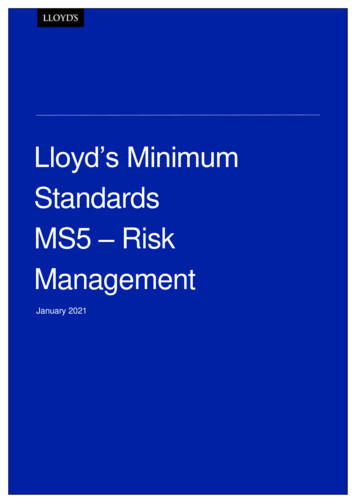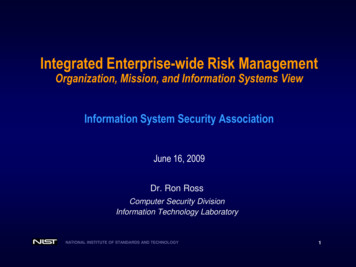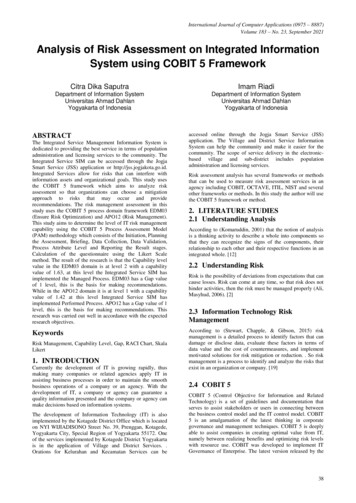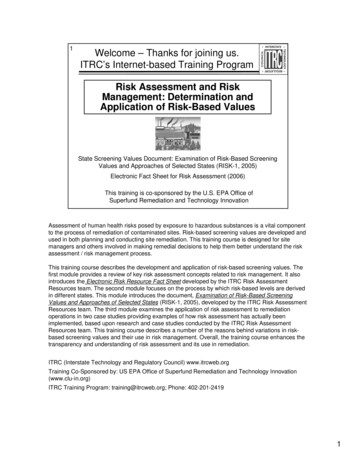
Transcription
1Welcome – Thanks for joining us.ITRC’s Internet-based Training ProgramRisk Assessment and RiskManagement: Determination andApplication of Risk-Based ValuesState Screening Values Document: Examination of Risk-Based ScreeningValues and Approaches of Selected States (RISK-1, 2005)Electronic Fact Sheet for Risk Assessment (2006)This training is co-sponsored by the U.S. EPA Office ofSuperfund Remediation and Technology InnovationAssessment of human health risks posed by exposure to hazardous substances is a vital componentto the process of remediation of contaminated sites. Risk-based screening values are developed andused in both planning and conducting site remediation. This training course is designed for sitemanagers and others involved in making remedial decisions to help them better understand the riskassessment / risk management process.This training course describes the development and application of risk-based screening values. Thefirst module provides a review of key risk assessment concepts related to risk management. It alsointroduces the Electronic Risk Resource Fact Sheet developed by the ITRC Risk AssessmentResources team. The second module focuses on the process by which risk-based levels are derivedin different states. This module introduces the document, Examination of Risk-Based ScreeningValues and Approaches of Selected States (RISK-1, 2005), developed by the ITRC Risk AssessmentResources team. The third module examines the application of risk assessment to remediationoperations in two case studies providing examples of how risk assessment has actually beenimplemented, based upon research and case studies conducted by the ITRC Risk AssessmentResources team. This training course describes a number of the reasons behind variations in riskbased screening values and their use in risk management. Overall, the training course enhances thetransparency and understanding of risk assessment and its use in remediation.ITRC (Interstate Technology and Regulatory Council) www.itrcweb.orgTraining Co-Sponsored by: US EPA Office of Superfund Remediation and Technology Innovation(www.clu-in.org)ITRC Training Program: training@itrcweb.org; Phone: 402-201-24191
2ITRC (www.itrcweb.org) – Shaping theFuture of Regulatory AcceptanceXXHost organizationNetwork State regulatorsX All 50 states and DC Federal partnersXDOEDODEPA ITRC Industry AffiliatesProgramWide variety of topics Technologies Approaches Contaminants SitesProducts Documents Technical and regulatoryguidance documents Technology overviews Case studies Training Academia Community stakeholders Internet-based ClassroomThe Interstate Technology and Regulatory Council (ITRC) is a state-led coalition ofregulators, industry experts, citizen stakeholders, academia and federal partners that work toachieve regulatory acceptance of environmental technologies and innovative approaches.ITRC consists of all 50 states (and the District of Columbia) that work to break down barriersand reduce compliance costs, making it easier to use new technologies and helping statesmaximize resources. ITRC brings together a diverse mix of environmental experts andstakeholders from both the public and private sectors to broaden and deepen technicalknowledge and advance the regulatory acceptance of environmental technologies. Together,we’re building the environmental community’s ability to expedite quality decision makingwhile protecting human health and the environment. With our network of organizations andindividuals throughout the environmental community, ITRC is a unique catalyst for dialoguebetween regulators and the regulated community.For a state to be a member of ITRC their environmental agency must designate a StatePoint of Contact. To find out who your State POC is check out the “contacts” section atwww.itrcweb.org. Also, click on “membership” to learn how you can become a member of anITRC Technical Team.2
3ITRC Disclaimer and CopyrightAlthough the information in this ITRC training is believed to be reliable and accurate,the training and all material set forth within are provided without warranties of anykind, either express or implied, including but not limited to warranties of theaccuracy, currency, or completeness of information contained in the training or thesuitability of the information contained in the training for any particular purpose. ITRCrecommends consulting applicable standards, laws, regulations, suppliers ofmaterials, and material safety data sheets for information concerning safety andhealth risks and precautions and compliance with then-applicable laws andregulations. ECOS, ERIS, and ITRC shall not be liable for any direct, indirect,incidental, special, consequential, or punitive damages arising out of the use of anyinformation, apparatus, method, or process discussed in ITRC training, includingclaims for damages arising out of any conflict between this the training and any laws,regulations, and/or ordinances. ECOS, ERIS, and ITRC do not endorse orrecommend the use of, nor do they attempt to determine the merits of, any specifictechnology or technology provider through ITRC training or publication of guidancedocuments or any other ITRC document.Copyright 2007 Interstate Technology & Regulatory Council,444 North Capitol Street, NW, Suite 445, Washington, DC 20001Here’s the lawyer’s fine print. I’ll let you read it yourself, but what it says briefly is: We try to be as accurate and reliable as possible, but we do not warrantee this material. How you use it is your responsibility, not ours. We recommend you check with the local and state laws and experts. Although we discuss various technologies, processes, and vendor’s products, we are notendorsing any of them. Finally, if you want to use ITRC information, you should ask our permission.3
4ITRC Course Topics Planned for 2008 –More information at www.itrcweb.orgPopular courses from 2007XXXXXXXXXXXCharacterization, Design, Construction,and Monitoring of Bioreactor LandfillsDirect Push Well Technology for Longterm MonitoringEvaluate, Optimize, or End Post-ClosureCare at MSW LandfillsPerchlorate: Overview of Issues, Statusand Remedial OptionsPerformance-based EnvironmentalManagementPlanning & Promoting Ecological Re-useof Remediated SitesProtocol for Use of Five Passive SamplersReal-Time Measurement of Radionuclidesin SoilRemediation Process OptimizationAdvanced TrainingRisk Assessment and Risk ManagementVapor Intrusion Pathway: A PracticalGuidelineNew in 2008XXXXXXXXXBioremediation of DNAPLsDecontamination andDecommissioning ofRadiologically-ContaminatedFacilitiesEnhanced Attenuation:Chlorinated SolventsPhytotechnologyQuality Consideration forMunitions ResponseRemediation Technologiesfor PerchlorateContaminationSensorsSurvey of MunitionsResponse TechnologiesMore in development More details and schedules are available from www.itrcweb.org under “Internet-basedTraining.”4
5Risk Assessment and Risk Management:Determination and ApplicationLogistical Reminders Phone line audience9 Keep phone on mute9 *6 to mute, *7 to un-mute toask question duringdesignated periods9 Do NOT put call on hold Simulcast audience9 Useat the top of eachslide to submit questions Course time 2¼ hoursPresentation Overview Risk assessment and riskmanagementQuestions and answersExamination of risk-basedscreening values andapproaches of selected statesQuestions and answersCase studies to examine use ofrisk assessment in site cleanupLinks to additional resourcesYour feedbackQuestions and answersNo associated notes.5
6Meet the ITRC InstructorsBennett D. KottlerNevada Division of Environmental ProtectionCarson City, Nevada775-687-9374bkottler@ndep.nv.govAnna H. ButlerU.S. Army Corp of Engineers, Savannah DistrictSavannah, milFran CollierCA EPA Department. of ToxicSubstances ControlHuman and Ecological Risk DivisionSacramento, California916-255-6431fcollier@dtsc.ca.govBennett Kottler is a branch supervisor of the State of Nevada Petroleum Fund at the Nevada Division ofEnvironmental Protection's Bureau of Corrective Actions located in Carson City, Nevada. Since 2002, he hasgiven technical, regulatory, and fiscal oversight on remediation cases ranging from residential heating oiltanks to a 1,600-acre site used to test engines for the Gemini, Lunar Module, Apollo, and Space Shuttleprograms. For four years previously, Bennett served as an assistant professor and taught environmentalscience, policy, and education at the University of Nevada Reno in Reno, Nevada and Southern ConnecticutState University in New Haven, Connecticut. Bennett spent four years teaching science in New York City tostudents ranging in age from 6 to 60. Bennett has served as a team member of the ITRC's Risk ResourcesTeam since its inception in 2003. Bennett earned a bachelor's degree in biology from Boston University inBoston, Massachusetts in 1985, and a master's degree in 1994 and a doctorate in 1998, both inenvironmental toxicology from Cornell University in Ithaca, New York for his research on microbial ecologyand the fate of organic pollutants in soil, respectively.Anna H. Butler is a technical manager for the HTRW/Geotechnical Branch of the Savannah District of the U.S. ArmyCorps of Engineers. The Savannah District provides environmental restoration services to Department of Defensefacilities in Georgia, South Carolina, and North Carolina. Since 1995, Anna has worked in various capacities for siteslocated in these states and has provided assistance for other districts along the east coast as well. Most recently, Annahas worked with risk assessors on the preparation and interpretation of risk assessments for multiple RCRA sites as wellas the corrective action decisions. In previous years, Anna gained teaching experience as a graduate teaching assistantat the Georgia Institute of Technology and was assigned to the corporate training center for Gearhart Industries in FortWorth, TX for two years. Anna has been an active member of the ITRC's Risk Assessment Resources and UXO Teamssince 2004. Anna earned a bachelor’s degree in geology from the University of Georgia in Athens, GA in 1976; and amaster’s degree in geophysical sciences from the Georgia Institute of Technology in Atlanta, GA in 1990. Anna iscurrently a registered Professional Geologist in Georgia.Fran Collier is an associate toxicologist with the Department of Toxic Substances Control of California EPA, located inSacramento, California. Fran has worked as an associate toxicologist since 2004 and has reviewed numerous sitespecific risk assessments. Previously Fran worked for DTSC as a supervisor for a group responsible for overseeing siteremediations in Northern California ranging from abandoned mine sites, chemical release sites and naturally occurringasbestos issues. Fran has also worked in water quality doing limnological research and overseeing water qualityenhancement projects. Fran has taught college classes on environmental monitoring and site assessment. Fran is amember of the ITRC Risk Assessment Resources Team. Fran earned a bachelor of science degree in zoology from theUniversity of California at Davis in 1971 and a master of science degree in environmental engineering from the CaliforniaState University, Sacramento in 1987.6
7What You Will Learn Understanding the determination, and applicationof risk-based values is important for risk management.XXXXModule 1 - Introduction Highlight conceptsModule 2 – Screening values variation Survey results Approaches, Assumptions, and AlgorithmsModule 3 – Use of risk-based values Two case studiesResources Examination of Risk-Based Screening Values and Approachesof Selected States (RISK-1, 2005) Electronic Risk Resources Sheet (2006) Case Studies to Examine Use of Risk Assessment(2007 expected publication)** Understanding basis, approaches, and uses of values is more important than the values themselves**1. Values change more often than do risk assessment paradigms2. Application & basis of values is more usefulTwo years surveying regulators, reviewing data, and discussing the ways U.S. States use risk assessment toscreen and ultimately clean-up contaminated sites.State and federal regulators, representatives from Army Corp. of Engineers, citizen stakeholders, Industry, Navy,and DOE.Presentation divided into 3 Modules.- Assume literacy but a limited understanding,(perhaps a risk manager; risk assessors - already wrestled w/ many issues we'll address)1) Begin with an Introductory Module. Sets foundation for the other modules; clarifies key concepts:( Screening levels vs. Cleanup vs. target levels)2) 2nd Module. Present the results of survey of 13 States:- Compared screening levels- Dig into assumptions & algorithms used to *develop* risk-based screening levels to uncover approaches3) Last Module - 2 case studies of risk-based remediation"- How risk assessment is *actually used* in site remediation.(Info from Washington state and Washington D.C., supplement 13 States)Uncover the differences in approachesThroughout the presentation, we'll reference the ITRC Risk Assessment Resources TeamThe published States Screening Values DocumentAn electronic fact sheet with links to key internet resourcesUpcoming document that is the basis for Module 3, the Case Studies- Check links to some 3 dozen links to additional resources.7
8Benefits to Regulators and RiskManagersXBetter understanding of risk assessment Improved skills and project planningXComparison of risk assessment approach Inter-state information transfer Improved transparencyPublishing values is not enoughXEvaluate use of risk assessment in managingcleanupHope training is quick way to see how U.S. States handle risk-based cleanups from screening levelsto the basis of screening levels, to cleanup goals.1) Increased understanding of development & application of risk-based levels to screening &remediatingimproved oversight, project management, case oversight . . . and work w/toxicologists1a) Screening levels change1b) Exposure scenarios changei.e. NV- Applicability of Fed guidance?- Most urbanized State- Varied environments inc. Mountain & DesertsWhat is applicability of Fed guidance i.e. USEPA Region 9 PRGs2) Comparison of States' regulatory approach - Valuable2a) Work inter-state? From federal agency? New regulations and policies?Comparison Î Apply information from one State to the next.i.e. DoD and DOE covering NV and CA.2b) Value of increased transparency to regulated community: policymakers and public.- Challenge regulators about inter-State variation.- Numbers don't speak for themselves.- i.e. Acceptance of Science- i.e. FL stakeholders IMPROVED exposure assessment.Module 1 - Anna H. Butler, technical manager, Savannah District of the U.S. Army Corps ofEngineers.8
9Risk Assessment and RiskManagement: Determinationand Application of Risk-basedValuesMODULE 1:1Risk Assessment and Risk ManagementNo associated notes9
10Learning ObjectivesXReview basic risk assessment concepts that willbe illustrated in Modules 2 and 3 Risk-Based Screening Levels Use and variability in risk assessmentvs. risk-based remedial levelsXXUse of risk assessment in risk managementIdentify the role of risk communicationIn this module we will look at the larger picture of risk management and the relationship of riskassessment and screening levels with risk management. We will review the basic concepts of riskassessment, how they are applied to screening levels and the risk management decision-makingprocesses.This training session will focus on risk management as applied to “hazardous waste sites.” Toillustrate the concepts discussed and to simplify the discussion, this training session will focus on onemedia – soil.10
11Electronic Risk Resource SheetXXDeveloped by ITRC Risk TeamLocated http://www.itrcweb.org/gd Risk.asp Listed at bottom of the pageXCompilation of web-based resources for humanand ecological risk assessment TutorialsGuidance documentsDatabasesSpecial topicsRisk communicationThe Interstate Technology Regulatory Council (ITRC) Risk Assessment Resources Team (RiskTeam) has developed. This resource sheet of internet-based resources is available from theGuidance Document page at the ITRC website (www.itrcweb.org). Click on the link for the additionalresource pages.The resource sheet (Risk Assessment Fact Sheet) is divided into five sections:Understanding Risk Assessment, which includes tutorials at both the introductory and advanced levelHuman Risk Assessment, which includes links to (1) databases such as Integrated Risk InformationSystem (IRIS) and Health Effects Assessment Summary Tables (HEAST) and (2) guidelines such asRisk Assessment Guidance for Superfund (RAGS)Ecological Risk AssessmentSpecial Topics such as vapor intrusion, perchlorateAdditional LinksMost links connect to databases, tools, and topics that address risk assessment.(Disclaimer – it is not intended to be comprehensive and does not address such issues as tribal riskassessment, chemical-specific data, and uncertainty.)11
12Risk ManagementXXRisk management - the process of Controlling risks Weighing the alternatives Selecting the appropriate actionThese decisions take into account Risk assessment information Social and political issues Regulatory/policy issues Technological/economic issuesRisk Management is the action taken to protect human health or the environment from exposures toa hazardous substance or situation. Risk Managers must determine the best way to reduce oreliminate the risk to the receptor population.Risk Managers must also take into account the cost and feasibility of implementation for eachalternative considered, as well as regulatory approval of the action and any social or political issuesinvolved with the site or the technology.The framework for these risk management decisions and for selecting the remedial alternative isbased on CERCLA Guidance: “Nine Criteria of the National Contingency Plan” (40 CFR 300.410 )This guidance directs that each remedial alternative be compared against nine criteria identified, thenthe alternative that best fits is selected. These nine criteria are divided into three subgroups:Threshold Criteria –Be protective of human health and the environmentComply with applicable or relevant and appropriate requirements (ARARs)Balancing Criteria –Long term effectiveness and permanenceReduction of mobility, toxicity, or volumeShort term effectivenessImplementabilityCostModifying Criteria –State/ regulatory acceptanceCommunity acceptance12
13Conceptual Risk ManagementSpectrum for Contaminated SoilNo further studywarranted“Zero”concentrationRisk assessmentsprovide sitespecific cleanupgoalsScreeninglevelResponse actionclearly warrantedResponse level/cleanup goalVery highconcentrationFrom the 1996 EPA Soil Screening Guidance: Users GuideThis slide shows the continuum of where risk assessment is used in managing risks at hazardouswaste site cleanup.Not all sites will need the same level of remediation or management. The magnitude, type, andnumber of contaminants will the dictate level of remediation and management that is warranted. Thefigure in the slide above is a graphic illustration of the relationship between the magnitude of soilcontamination and the relative management response.Some decisions are clear cut, very low levels – no action; very high levels – remediation isnecessary. It is the middle area is where choices/decisions are not clear cut – that is where screeninglevels and risk assessment become valuable and where this and the following modules will focus. Asyou can see from the figure above, screening levels are used as the first step in the risk managementprocess to eliminate a site from further study or action. The response levels are site-specific cleanuplevels calculated from site data, above which remediation could be necessary.Risk Assessments are the tools used to develop screening and remediation levels, for making theserisk management decisions.Module 2 will discuss screening levels in more detail and examine the sources of some of thedifferences observed in the screening levels between various agencies. Module three will illustratehow these two levels are utilized in site investigations and remediation.The next slides are about risk and basic components of risk assessment, the final slides explain therelationship of screening levels to risk assessment and risk management.13
14What do We Mean by RiskAssessment?Risk Probability of suffering harmful effectsdue to exposure to site related constituentsExposureRiskToxicityProvides information and characterizes anypotential adverse effects of human exposureWhat do we mean by risk assessment? The qualitative or quantitative characterization andestimation of potential adverse health effects associated with individuals or populations to hazards.These hazards could be materials (physical, chemical or microbial in natures) or situations.The assessment is the process involved to determine whether a substance poses a risk, whatpopulation is susceptible to the risk and the extent (magnitude) that risk.The risk is the probability that these adverse effects will occur.Risk management-Uses the results of the risk assessment to determine the best way to reduce oreliminate the risk to a receptor (population) by controlling or eliminating one of the three basiccomponents; i.e.; eliminate the source, the pathway, or receptor.14
15What Value is a Risk Assessment?XXXEvaluates the need for protective action at a siteProvides a scientific and legally defensible basisto support risk management decisionsCan result in cost and time savings by Focusing corrective actions on the exposurepathways that present the highest risks Providing risk-based remediation goalsA risk assessment will evaluate the potential hazards to identified receptors from exposures to all sitehazards via the exposure pathways. Through this evaluation the need for any protective action orremediation can be identified. It will provide a scientific and legally defensible support to base riskmanagement decisions. Providing site-specific cleanup goals can result in cost savings instead ofusing background levels or screening levels for cleanup goals, or cleaning a site up to non-detectlevels.It can also allow for reuse of site by evaluating exposure pathways and restricting activities to avoidexposure while allowing for the reuse a site15
16Basic Components of a RiskAssessmentData Collectionand CharacterizationThe next few slides review the basic components or processes involved in a risk assessment.4 basic steps:1. Data collection2. Toxicity Assessment3. Exposure Assessment4. Risk Characterization3 Basic Components for Risk from substance to occur.SourcePathwayReceptor16
17Data Collection and EvaluationXXXXEvaluate entire site and site historyIdentify Source Media Pathways ReceptorsDevelop a site conceptual model Use to plan sampling/data needsReview and evaluate site dataThe first step involved is to develop a sampling plan that will address all exposure pathways from the source of thesuspected hazard to the receptors. A good way of doing that is to develop a site conceptual model that will identifyall the media, pathways, and receptors of concern. The site conceptual model can be used to plan sampling anddata needs for the site investigation and risk assessment to make sure that there will be no data gaps.The purpose of sample collection is to evaluate the site data to characterize the exposure for each receptor from allmedia. Environmental samples can be collected for different purposes. Sampling data collected to delineate fateand transport of chemicals may have provided insufficient data for risk assessment purposes. Samples needed forrisk assessment purposes are not necessarily the same as those to characterize the nature and extent of acontaminant. For a realistic exposure assessment, samples should come from all media that receptor would beexposed to and from the entire site area, not just those parts of the site that contain concentrations of thecontaminant. There also need to be a sufficient number of samples collected to perform valid statistical functionsused in the risk assessment processes.Sampling PlanAre the number of samples collected adequate for data needs and use.Is the coverage adequate to characterize site based on site size and history.Samples collected from all media of concern, are all pathways represented?Analytical NeedsDoes analytes list match chemicals of concern?Use recent, approved analytical methods?Evaluate reporting/detection limits vs. screening levels, data useModule 3 will discuss two case studies that illustrate how sampling plans are tailored to fit the needs of each siteinvestigation based on the risk assessment or remediation needs.This is the point in the risk assessment process at which the screening levels are employed. Chemicals detected inthe samples from each media are compared to the approved screening levels for each media. Those chemicalsthat exceed the screening levels are identified as chemicals of potential concern for further evaluation, while thosethat do not exceed can be eliminated.Module 2 will discuss screening levels in more detail. There are several sources of screening criteria and they willvary based on the regulatory program that a particular site investigation falls under. Different sources screeningcriteria will have different values listed for the same chemical allowing that chemical to be eliminated at this pointunder some programs, while classified for further evaluation under other programs. Module 2 will examine thesources of variance for some of the parameters that make up the differences in the various screening criteria.17
18Toxicity AssessmentXXProvides a summary of toxicity and potential effectsfrom exposures Toxicity Values are selected for risk calculationsTwo classifications for toxic effects Carcinogenic Exposure has potential to result in cancer Toxicity values described by a “cancer slope factor” Noncarcinogenic Anything else Exposure above a threshold level could result inadverse effect Toxicity values described by a “reference dose”Toxicity assessment is not a risk assessment, but simply the assessment of whether a chemicaldetected in a media will have an adverse effect on the receptor. The toxicity assessment usesinformation from experiments in animals to infer that the same results will occur in humans anddescribes the relationship between the amount of exposure and the extent of harmful effects.During the toxicity assessment, toxicological information is reviewed for each site related chemical ofconcern to select the most appropriate toxicity value for use in the risk calculations. Toxicity valuesare derived from the does-response studies.Two classifications for these adverse effect based on the weight of evidence from the various studiesdocumenting long-term/short term effects.1. Carcinogenic EffectsAn exposure has the potential to keep causing the effect, so that one molecule could causecancer (unlikely but possible). Potency described by Cancer Potency Factor (Slope Factor)in units of (mg/kg-day)-1 The Cancer Slope Factor is the 95% UCL of the slope of the doesresponse curve.2. Noncarcinogenic EffectsChemicals have a threshold based on studies; exposures below this level will not haveadverse effects. If you remove the exposure, you stop the effect.Potency described by reference doses in units of mg/kg-dayNoncarcinogenic effects include health effects like organ damage. For instance, at low doses Tylenolis therapeutic but at high doses can damage the kidneys18
19Exposure AssessmentXIdentifies and describes Receptors to site related constituents Pathways for exposure Concentration and length of time ofexposureXCalculate the Average Daily Intake(Dose) Each receptor Each pathway Each site-related constituent ofconcernThe exposure assessment is the part of the risk assessment process that describes the type and sizeof the population at risk (receptors) and the extent and duration of their exposure. These can becurrent, past, or future exposures. During the exposure assessment the potential daily dose of thesuspected chemical that a receptor will be exposed to via all exposure pathways is calculatedExposure Pathways: Three Main Exposure Pathways1. Dermal - skin exposure from dust, surface soils from work activities, recreational activities,groundwater by bathing, showering, swimming.2. Oral - ingestion of soils (dust), water3. Inhalation - breathing contaminated dust or vapors- Activity dependentIn some rare cases there could also be an intravenous exposure - a cut that exposes blood vessels.Exposure is generally expressed in terms of how much a receptor will be exposed to in one day withan Average Daily Intake (Also commonly termed Chronic Daily Intake)Start by using default exposure parameters. Then ask if these default exposure parameters (veryconservative) are reasonable or too conservative based on site history and expected use.As you will see in Module 2, risk based screening levels use very conservative exposure parametersfor these exposure assumptions. In a site-specific risk assessment, there might be e morereasonable exposure parameters for a particular site based on expected use or site history.19
20Exposure Assessment (continued)(AverageDaily Dose (Chemical meExposure parameters Terms used to calculate an average daily intake or “dose”per chemical per media per receptor for a specific exposuretimeExposure parameters vary per receptor i.e.; for an adult the default exposure duration is 24 years,while for a child 6 years is commonly usedThis is the most basic general equation. This equation
The third module examines the application of risk assessment to remediation . Bennett earned a bachelor's degree in biology from Boston University in Boston, Massachusetts in 1985, and a master's degree in 1994 and a doctorate in 1998, both in . Fran has taught college classes on environmental monitoring and site assessment. Fran is a




